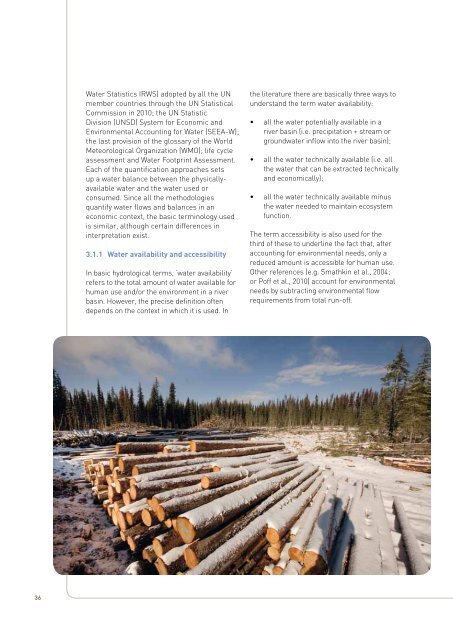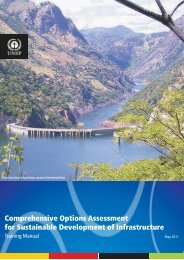MEASURING WATER USE IN A GREEN ECONOMY - UNEP
MEASURING WATER USE IN A GREEN ECONOMY - UNEP
MEASURING WATER USE IN A GREEN ECONOMY - UNEP
Create successful ePaper yourself
Turn your PDF publications into a flip-book with our unique Google optimized e-Paper software.
Water Statistics IRWS) adopted by all the UN<br />
member countries through the UN Statistical<br />
Commission in 2010; the UN Statistic<br />
Division (UNSD) System for Economic and<br />
Environmental Accounting for Water (SEEA-W);<br />
the last provision of the glossary of the World<br />
Meteorological Organization (WMO); life cycle<br />
assessment and Water Footprint Assessment.<br />
Each of the quantification approaches sets<br />
up a water balance between the physicallyavailable<br />
water and the water used or<br />
consumed. Since all the methodologies<br />
quantify water flows and balances in an<br />
economic context, the basic terminology used<br />
is similar, although certain differences in<br />
interpretation exist.<br />
3.1.1 Water availability and accessibility<br />
In basic hydrological terms, ‘water availability’<br />
refers to the total amount of water available for<br />
human use and/or the environment in a river<br />
basin. However, the precise definition often<br />
depends on the context in which it is used. In<br />
the literature there are basically three ways to<br />
understand the term water availability:<br />
• all the water potentially available in a<br />
river basin (i.e. precipitation + stream or<br />
groundwater inflow into the river basin);<br />
• all the water technically available (i.e. all<br />
the water that can be extracted technically<br />
and economically);<br />
• all the water technically available minus<br />
the water needed to maintain ecosystem<br />
function.<br />
The term accessibility is also used for the<br />
third of these to underline the fact that, after<br />
accounting for environmental needs, only a<br />
reduced amount is accessible for human use.<br />
Other references (e.g. Smathkin et al., 2004;<br />
or Poff et al., 2010) account for environmental<br />
needs by subtracting environmental flow<br />
requirements from total run-off.<br />
36

















